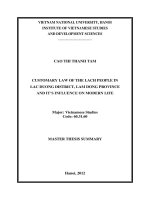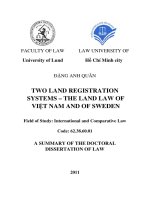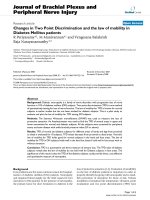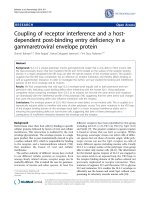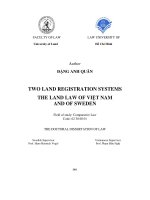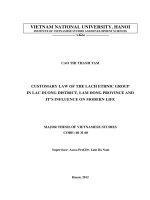GEARS AND GEAR TRAINS - INTRODUCTION, TYPES, NOMENCLATURE, FORMS, LAW OF GEARING, INTERFERENCE, INTERCHANGEABLE GEARS, NON-STANDARD GEARS, HELICAL AND SPIRAL GEARS, WORM AND WORM GEAR, GEAR TRAINS, AUTOMOBILE TRANSMISSION GEAR TRAINS ĐIỂM CAO
Bạn đang xem bản rút gọn của tài liệu. Xem và tải ngay bản đầy đủ của tài liệu tại đây (5.94 MB, 62 trang )
Gears and
Gear Trains
Introduction
Gears are used to transmit motion from one shaft to
another or between a shaft and a slide. This is
accomplished by successfully engaging teeth.
Types of Gears
1. Parallel Shafts Gear (large gear)
Spur gears – tooth profile is parallel
to the axis of rotation, transmits
motion between parallel shafts.
Internal Pinion (small gear)
gears
Pinion
Spur Rack and Pinion sets – a Rack
special case of spur gears with
the gear having an infinitely
large diameter, the teeth are
laid flat.
1. Parallel Shafts
Helical gears– teeth are inclined
to the axis of rotation, the angle
provides more gradual
engagement of the teeth
during meshing, transmits
motion between parallel shafts.
Herringbone gears- To avoid
axial thrust, two helical gears of
opposite hand can be mounted
side by side, to cancel resulting
thrust forces
Herringbone gears are mostly
used on heavy machinery.
2. Intersecting shafts Straight
bevel
Bevel gears – teeth are formed on a gear
conical surface, used to transfer
motion between non-parallel and
intersecting shafts. Straight bevel
gears make line of contact similar
to spur gears
Spiral bevel gears- smoother in Spiral
action and quieter than straight bevel
bevel gears. gear
Zero Bevel Gear- In this bevel gear
spiral angle is zero at the middle of
the face width
3. Skew shafts (non- parallel and non-
intersecting)
In case of Skew shafts (Non- parallel- non-intersecting) a uniform rotary
motion is not possible as in case of parallel and intersecting shafts which
has pure rolling contact
Worm gear sets – consists of a helical gear
and a power screw (worm), used to transfer
motion between non-parallel and non-
intersecting shafts.
Crossed Helical gears- Applicable to light
load conditions. Used to drive feed
mechanisms in machine tools, camshafts,
and small IC engines
3. Skew shafts (non- parallel and non- intersecting)
Nomenclature
Smaller Gear is Pinion and Larger one is the gear
In most application the pinion is the driver, This
reduces speed but it increases torque.
Terminology
Pitch circle, theoretical circle upon which all calculation is based
Pc, Circular pitch is the distance from one teeth to the next, along the pitch
circle.
Note : If D1 and D2 are the diameters of the two meshing gears having the teeth
T1 and T2 respectively, then for them to mesh correctly,
m, module=d/T , pitch circle diameter/number of teeth
Therefore Circular pitch, Pc= πm
Pd, Diametral Pitch , Number of teeth per unit length,
Pd =T/D= t/d=1/m
Pc Pd = π
Backlash
It is the difference between the tooth space and the tooth thickness,
as measured along the pitch circle. Theoretically, the backlash should
be zero, but in actual practice some backlash must be allowed to
prevent jamming of the teeth due to tooth errors and thermal
expansion.
Velocity Ratio (VR)
The velocity ratio is defined as the ratio of the angular
velocity of the driven gear to the angular velocity of the
driving gear
VR= ω2 / ω1 (D= diameter of driven gear; d= diameter of driving gear)
= N2 / N1 (ω= 2πN)
=d /D (V=π d N1 = π D N2)
=t/T (p= π d/ T1 = π D / T2 )
Pressure line and pressure angle
•The standard pressure angles are 14 1/2 ° and 20°
Pressure line
CP- path of approach
PD- Path of recess
Arc of contact- arc APB or EPF
Arc of approach- AP or EP
Arc of recess- PB or PF
Angle of action (δ)= Angle of approach(α) + Angle of recess (β)
Contact ratio= Angle of action (δ) Pitch angle (𝛾) = Arc of contact Circular pitch
[Pitch angle (𝛾) - Angle subtended by circular pitch at the center of gear]
Contact ratio
Number of pairs of teeth in contact
Contact ratio= Angle of action (δ) Pitch angle (𝛾) = Arc of contact Circular pitch
Contact ratio should be always greater than unity to ensure
continuous transmission of motion, for at least one pair of teeth
should be in meshed condition for the mating gears.
If contact ratio is 1.6, it means that one pair of teeth is always in
contact whereas two pairs of teeth are in contact for 60% of the
time.
FORMS OF TEETH
1.Cycloidal profile
2.Involute profile
Cycloid




